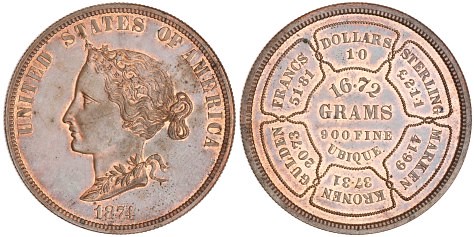
PREV ARTICLE
NEXT ARTICLE
FULL ISSUE
PREV FULL ISSUE
DANA BICKFORD'S PATTERN COINAGE
One of my favorite numismatic blogs is Pocket Change, published by the American Numismatic Society. Here's an excerpt from
Matthew Wittmann's September 3, 2015 post on Dana Bickford's pattern coinage. Interesting. -Editor

This past week I have been working on my presentation for the upcoming International Numismatic Congress, which concerns U.S. trade dollars, the ill-fated silver coin issued in the 1870s for trans-Pacific commerce. Although the trade dollar was the only one struck for international circulation, there were some interesting patterns dating to this period of expanding global commerce, perhaps most notably the 1874 ‘Bickford’ $10 coin. This particular $10 pattern coin was suggested by the seemingly indefatigable Dana Bickford (1834-1909), a businessman and inventor who had the ear of Henry R. Linderman, the superintendent of the United States Mint. Dana Bickford’s most notable legacy, at least for numismatists, was the idea for a coin that he proposed to Henry Linderman for the US Mint in 1874. The genesis of the pattern was detailed in the February 1876 edition of the Coin & Stamp Journal, which reprinted an article that originally appeared in the Philadelphia Inquirer on January 31. The summary version is that Bickford was traveling through Europe in 1873 and experienced all the “difficulties and inconveniences” that accompanied exchanging for and understanding the “money current” in each of the countries that he visited. (That part of the story checks out as Bickford lodged an application with the Department of State for a passport in February 1873). The idea he hit upon while traveling was for a coin that would have its exact composition on its face, as well as its value in terms of each of the major commercial currencies. Bickford called at the mint in Philadelphia when he returned, and Linderman thought enough of the idea that dies were prepared and a pattern was struck. The ANS holds a copper specimen (Judd-1374), but it was also struck in aluminum, nickel, and gold. Bickford’s proposed system of international coinage would allow countries to display their own particular design on the obverse (hence the Liberty Head), but required that the fineness, weight, and exchange value of the coin be expressed on the reverse. Although struck in copper, this was supposed to be a $10 gold coin or Eagle with a weight of 16.72 grams. The indication that it was .900 fine meant that it contained 15.046 grams or .48375 troy ounces of pure gold. Six cartouches circle the reverse with the value of the coin in US dollars ($10), British pounds (£2.1.1), German marks (41.99), Danish kroner (37.31), Dutch gulden (20.73), and French francs (51.81). The UBIQUE inscription stands for ‘ubiquitous,’ implying that the coin was good everywhere. Although this was likely an impossible scheme to implement in practical terms, the coin was an intriguing idea in theory. Beginning with the formation of the Latin Monetary Union in 1865, there were a series of international monetary conferences and related efforts to create a more uniform and stable global currency system. The big problem for Bickford’s proposed coinage was that although the price of gold was relatively steady, not all nations were on a gold standard. A drop in the price of silver during the 1870s destabilized the currencies of those countries on a silver or bimetallic standard by dramatically shifting the gold price of silver. This in turn led to fluctuations in exchange rates that would have been impossible to keep up with in terms of minting and circulating coins.
Bickford rather optimistically expressed the hope, which is inscribed on the obverse, that “This Combination Coin Will When Adopted be Good in All Nations / Heal All Differences Between Gold & Silver Men / and Fully Settle All Financial Questions.” To read the complete article, see:
Wayne Homren, Editor The Numismatic Bibliomania Society is a non-profit organization promoting numismatic literature. See our web site at coinbooks.org. To submit items for publication in The E-Sylum, write to the Editor at this address: whomren@gmail.com To subscribe go to: https://my.binhost.com/lists/listinfo/esylum All Rights Reserved. NBS Home Page Contact the NBS webmaster 
|
